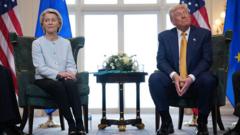In a turn of events following the recent EU-US trade agreement announcement, European leaders, including European Commission chief Ursula von der Leyen, have expressed significant concerns regarding the details of the deal that appears to be far from finalized. The trade deal, celebrated initially as a means to avoid the daunting 30% tariffs previously threatened by the Trump administration, has revealed critical discrepancies that may lead to adverse consequences for several EU countries.
While a reduction to a 15% tariff on most goods marks progress from earlier threats, many leaders are questioning the lack of a tougher stance during negotiations. Germany's finance minister Lars Klingbeil noted his disappointment with the outcome while still acknowledging the importance of stabilizing the market. However, expressions of relief have been muted, especially in light of comments from French President Emmanuel Macron, who emphasized that this should be viewed merely as the first step in an ongoing negotiation process.
The structural uncertainties have raised eyebrows among observers, particularly given the contrasting interpretations of various aspects of the agreement. The US administration has underscored a commitment from the EU to invest significantly in American energy and defense sectors, while EU officials have been cautious, stating that such commitments have not been legally ratified and in fact remain intentions rather than guarantees.
Countries like Germany, Ireland, and Italy find themselves at a substantial disadvantage, with many industries—most notably automotive and pharmaceuticals—set to incur significant costs due to the new tariffs. As Ireland is notably dependent on the US for a large percentage of its exports, the agreement has been received with a mix of resignation and regret, given the financial implications.
Trade experts predict that the negotiations surrounding the agreement will be drawn out over the coming months, as the EU seeks to protect its industries without shouldering the financial burden of compensatory measures. Industry advocates warn against a blanket resolution that could ultimately shift the burden of tariffs onto European taxpayers, a scenario that would undermine the desired outcomes of the agreement.
Ultimately, as the EU and US continue to navigate this complex trade landscape, the pressure will be on European negotiators to secure a fairer, more balanced agreement that addresses the needs of the diverse economies within the bloc. The road ahead is fraught with challenges, but EU representatives remain hopeful for more favorable outcomes as discussions progress.
While a reduction to a 15% tariff on most goods marks progress from earlier threats, many leaders are questioning the lack of a tougher stance during negotiations. Germany's finance minister Lars Klingbeil noted his disappointment with the outcome while still acknowledging the importance of stabilizing the market. However, expressions of relief have been muted, especially in light of comments from French President Emmanuel Macron, who emphasized that this should be viewed merely as the first step in an ongoing negotiation process.
The structural uncertainties have raised eyebrows among observers, particularly given the contrasting interpretations of various aspects of the agreement. The US administration has underscored a commitment from the EU to invest significantly in American energy and defense sectors, while EU officials have been cautious, stating that such commitments have not been legally ratified and in fact remain intentions rather than guarantees.
Countries like Germany, Ireland, and Italy find themselves at a substantial disadvantage, with many industries—most notably automotive and pharmaceuticals—set to incur significant costs due to the new tariffs. As Ireland is notably dependent on the US for a large percentage of its exports, the agreement has been received with a mix of resignation and regret, given the financial implications.
Trade experts predict that the negotiations surrounding the agreement will be drawn out over the coming months, as the EU seeks to protect its industries without shouldering the financial burden of compensatory measures. Industry advocates warn against a blanket resolution that could ultimately shift the burden of tariffs onto European taxpayers, a scenario that would undermine the desired outcomes of the agreement.
Ultimately, as the EU and US continue to navigate this complex trade landscape, the pressure will be on European negotiators to secure a fairer, more balanced agreement that addresses the needs of the diverse economies within the bloc. The road ahead is fraught with challenges, but EU representatives remain hopeful for more favorable outcomes as discussions progress.

















